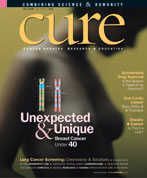Screening: Finding the Tumor
Breast cancer screening for women at high risk.
High-risk women can develop breast cancer at a relatively young age when the breasts are dense, making it more difficult to detect a tumor using traditional mammography. But doctors are finding success with newer tests.
Magnetic Resonance Imaging (MRI)
Adding MRI to X-ray mammography would detect most tumors in women at high risk for breast cancer, says a recent Lancet study. The ability to detect a breast tumor increased from 40 percent with mammography alone to 94 percent when combined with MRI. The detection rate with MRI alone was also impressive, particularly among women in the study who tested positive for a BRCA1 mutation. Twenty-three percent of cancers in this subgroup were detected with mammography compared with 92 percent found with MRI.
MRI hasn’t become a mainstream breast-screening method like mammography because the test, which typically takes 30 to 60 minutes, leads to a high rate of false-positives. Mammography is also much better at detecting DCIS than MRI.
Most experts agree MRI scanning of the breast should be reserved for women at highest risk because of a strong family history, those with dense breasts and women with breast implants. In addition, MRI can cost at least 10 times as much as mammography—$1,000 or more, depending on geographic region, compared with $100-$150 for a mammogram.
Digital Mammography
Instead of acquiring an image on film, as with conventional mammography, the image is collected electronically and can be stored directly on a computer very similar to a digital photo. The image can be manipulated electronically, allowing a technician to zoom in and out or increase contrast. Images can be e-mailed and new software is making reading the images easier. Digital mammography only shows structural changes and as of yet has not been shown to be more effective than standard mammography in finding breast cancer.
Preliminary results from a large clinical trial of digital versus film mammography (DMIST) show no difference in detecting breast cancer for the general population of women in the trial. However, those women with dense breasts, who are pre- or perimenopausal (women who had a last menstrual period within 12 months of their mammograms), or who are younger than age 50 may benefit from having a digital rather than a film mammogram.
